Enterprises typically spend approx. half their IT budget in maintenance and upkeep of IT infrastructure like hardware and software. With such huge investment in maintenance of legacy support systems, it becomes imperative for enterprises to look at the various options available to them for optimizing their costs and efforts in managing the same. The ongoing pandemic has also spurred conversations around how budgets can be allocated and managed more effectively due to an increase in remote working requirements and other challenges.
While cloud services have been on offer for some time now, banks and financial institutions have historically opted for on-premise services that allow them to retain and exercise control and management over the entire ecosystem of services deployed by the bank. Both these solutions have their pros and cons which should be weighted on their own merits to help institutions develop their own framework of preference.
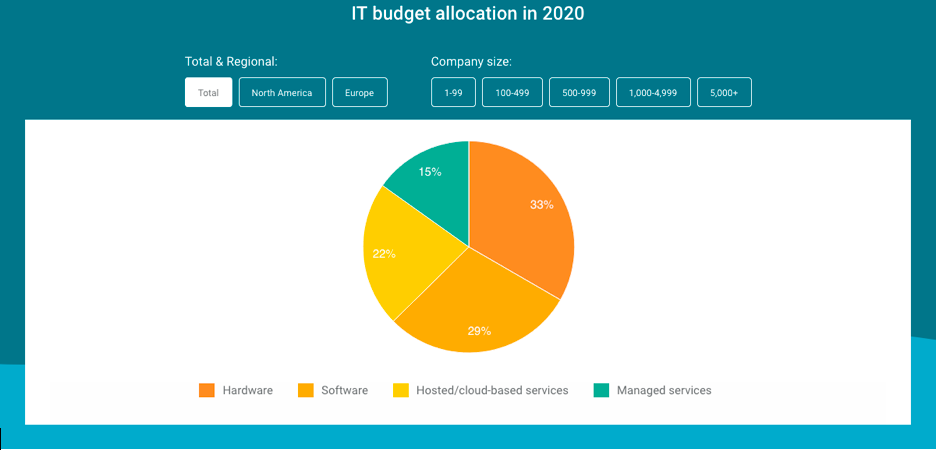
The above chart showcases a distribution of the IT budget allocation by spend category. Clearly, infrastructure forms a large segment of IT spend.
One of the key driving factors for IT spending seems to be the need to upgrade existing/outdated infra.
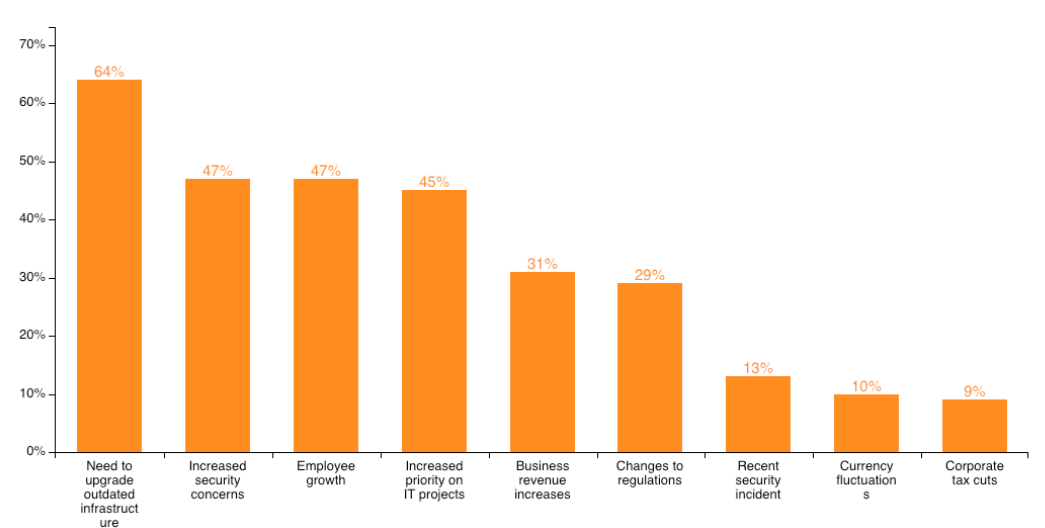
Clearly, there is a significant need in the market to look at the various deployment options available among cloud managed and on-premise services.
On-Prem vs Cloud Storage

|
Factor |
Cloud |
On-Premises |
| Software | SaaS fees are typically paid monthly or annually based on peak concurrent use for the given period or as a fee for a given not-to-exceed volume. | A perpetual or term license for the peak number of users (or other metric) is purchased upfront or via an annual subscription. There is also option for predictable subscription pricing and live usage & billing calculator to track expenses. |
| Hardware | Hardware needs to be procured in advance and are generally expensive to buy on a unit purchase basis. | Hardware is managed by cloud service provider via redundancy and is bundled into the subscription fee. |
| Human Resources | Trained service personnel and dedicated IT support staff need to be maintained adding to cost overheads. | While most services are automated, dedicated support staff is available 24×7 through dedicated service lines. However, there is still a necessity for project governance hence some project management costs should be factored into the same. |
The key differentiators between an on-prem managed service and cloud managed service is well established at this point. Hence, we would only like to summarize the key elements here.
On-Prem Storage
- All services – hardware and software is fully procured, owned and managed by the enterprise
- Enterprise is solely responsible for the security and sanctity of the platform
- Investment is in CAPX – Capital Expenditure based, comprising of a one-time high expense that is paid in full and depreciated over the lifecycle of the service
- Key Pain Area –
- On-premise services require enterprises to plan for all elements related to the infra – Number of virtual machines, CPUs, servers, RAM capacity, storage capacity etc. Hence, scalability is not dynamic and resource requirements need to be planned in advance which can lead to redundancy and overhead.
Cloud Storage
- Storage services are owned and managed by a third party service provider
- Security can be multi-tiered – with cloud provider providing their own security features and services to secure platform along with enterprise specific security elements being deployed in a secure instance for critical data
- Pay-as-you-go models available depending upon usage, data traffic, time-limited usage etc.
- Investment is generally considered OPEX – Operational Expenditure, billed on a monthly, annual or periodic basis but which generally tends to lower periodic overall costs.
- Key Area of Concern –
- For enterprises accustomed to maintaining and managing services on their own, vesting control to a third party service provider can be difficult. It is also important to check the provider’s credentials and services need to be strictly audited to ensure there is no data leakage or service deficiency.
On-Prem vs Cloud Storage – Cost Comparison
There are two components to infrastructure costs –
- Cost of new procurement
- Cost of replacement/repair
The variable cost components among on-premises vs cloud services are summarized in the imae below –
We also provide a comparison of the Total Cost of Ownership as computed over a period of time.
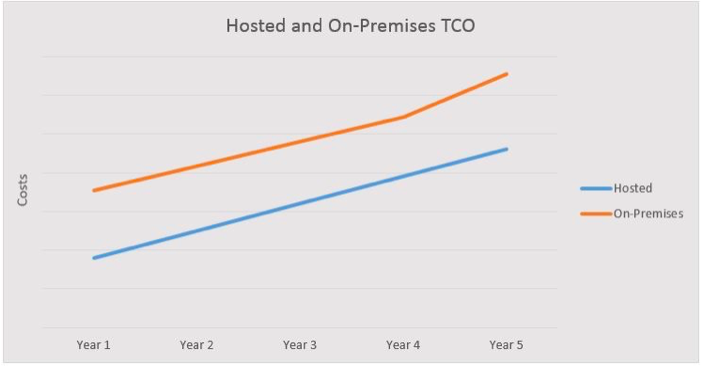
Overall, cloud managed or hosted services provide significant cost savings in the long run.
On-Prem vs Cloud Services – Time Comparison
Time to deployment is much faster for cloud services compared to on-prem services. This is due to 3 major factors –
- Standardized deployment models and container support
- Dynamic scalability basis usage and memory requirement
- Lower latency and improved response time hence overall efficiency is much higher
A typical time-to-deployment comparison model for cloud vs on-prem services is provided below –
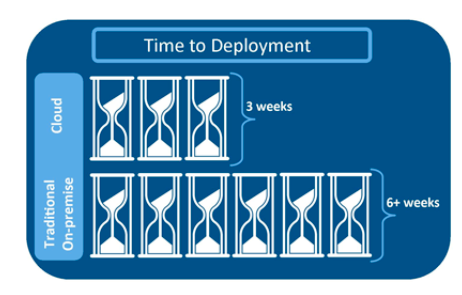
On-Prem vs Cloud Services – Product Benefit Analysis
|
Factor |
Cloud |
On-Premises |
| Business Agility | By offering self-service for reporting, analytics, configuration, and access (in-the-box customization), many cloud providers promote business agility. This can be tied to time-to-market acceleration for revenue growth and cost savings initiatives. | Traditional on-premise deployment requires complex code-level customized processes and little or no automation. |
| User Productivity | Many SaaS applications include the most current version, easy to follow user interfaces, and delivery from multiple data centers to reduce the latency caused by the distance between the application, the data, and the end user (see data gravity). Ease-of-use, performance, and accessibility yield higher productivity. | Many larger enterprises mimic the cloud experience via workspace applications that include single-sign-on and access to a unified set of applications. However, the proximity of the user to the data center can still impact latency and the need to access through a VPN can limit usability. |
| User Onboarding / Removal | Many cloud applications put this activity in the hands of the business users—simple user interface, simple process of setting up or removing user IDs and passwords. | On-premises solutions may necessitate IT’s involvement and can result in delays. Time-to-onboard a new hire has become a critical factor for hiring and retaining new talent. |
| Reliability | SaaS providers are generally bound by audited measures to ensure up to 99.999% uptime. | On-premises solutions require their IT teams to architect solutions that do not fail. However, it is rare to see on-premises at three 9s (99.9% uptime). Downtime can impact revenue, user productivity, and certainly comes with an IT cost. |
| Scalability | Scalability often just involves adding more user ID/password combinations (and ensuring bandwidth). | On-premises scalability may involve provisioning more hardware, more routers, etc., plus acquiring additional licenses—so IT and procurement heavy. |
As the above clearly indicates, there are key benefits that enterprises can leverage by implementing solutions on the cloud which ensure high reliability, reduced overhead and maintenance costs, and overall a lower TCO. Moving from legacy architecture to high-speed cloud managed services can lead to significant business productivity and increased revenue and ROI on your IT spending.
What is Vahana Cloud Platform & How it can help accelerate digital transformation?
Vahana Cloud Platform is an Integrated Application Development and Management platform that allows enterprises to rapidly build, test and deploy reliable and scalable enterprise applications across your preferred deployment models – be it cloud, on-prem or hybrid.
Vahana is a GCP, AWS, Azure-ready technology platform which utilizes reusable modules and microservices to enable digital solutions for Digital Banking and Financial Solutions.
For Banks and NBFCs, the biggest benefit is it is a single unified platform to manage all their banking journeys and products.
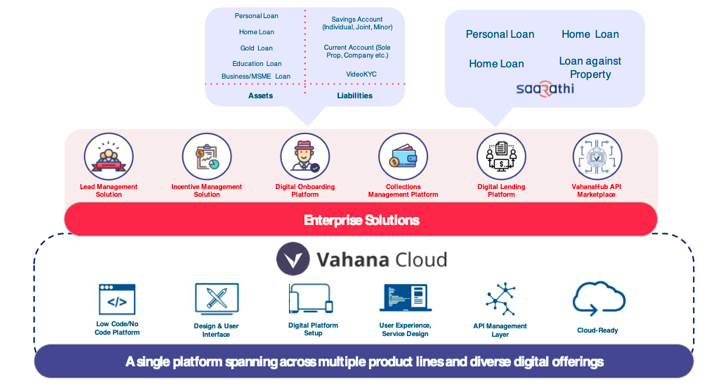
To know more about how Decimal’s Vahana Cloud Platform can help accelerate digital transformation for your organization, connect with us at https://decimaltech.com/vahana-cloud-platform/.